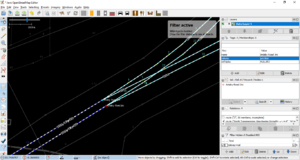UKRail Project
A large UK rail project to import information including maxspeeds, LOR/ELR codes, loading gauges, route availability, crossings, buffer stops and TIPLOCs.
Network Rail have given permission to use NESA and/or the Sectional Appendix to add extra information to the UK rail network. No physical information such as signal locations will be added as Network Rail have crime issues in regards to that. A Freedom of Information request has been submitted and if approved, the signal locations will be added but it is not likely to be approved.
Methodology
I will be going through each line systematically ensuring data is correct with no automatic edits. The project will be split into phases.
Phase 1: Loading Gauge, Route Availability and LOR codes. The LOR codes will allow easier identification for later tasks. I usually do these at the same time as they can be done be done in bulk and relatively quickly.
Phase 2: Track direction, ELR and Seq codes allowing more specific identification of tracks.
Phase 3: TIPLOCs to ensure all stations, junctions and stops have a TIPLOC code.
Phase 4: Crossings and max speeds.
I use JSOM with only the rail network visible ensuring that no other nodes will be edited by accident. I also use overpass to find areas that are missing details.
Sources
Sectional Appendix - As mentioned above, Network Rail has allows the use of the publicly published Sectional Appendix (but also NESA). This opens up more information on the UK rail network.
Junction Maps - Raildar have junction maps that make it easier to locate junctions and LOR references.
ABCRailwayGuide - Other sources such as ABCRailwayGuide will be used for crossings names (but they are also in the Sectional Appendix).
Tagging
Tracks
I have noticed that some dual tracks are drawn using only one line; I will draw both tracks individually. UK trains tend to travel on the left so directions will be changed to match and if a track is bidirectional then oneway=no will be used.
Max Speed
NESA contains specific maximum speeds for locations within the network.
maxspeed - Speed as shown in NESA unless there is a dual speed limit (i.e. for tilting trains) in mph.
maxspeed:tilting - Some areas allow faster speeds for specific trains i.e. Sprinter Trains
maxspeed:forward / maxspeed:backward - Some tracks are single but have different speeds for different directions.
Reference Codes
There is a inconsistency in regards to ref, as sometimes it's a ELR code but sometimes it's LOR code.
ref:lor - Line of Route is the name of a strategic rail route.
ref:elr - Engineers Line Reference allows engineers to identify specific lines.
ref:seq - Sequence allows finding the page within the Sectional Appendix (optional).
Crossings
Crossings will be tagged appropriately (Road/Path) and named.
Junctions
A tough one. Junctions will be tagged on the node where the route splits, but only in a way the train would hit it once. I have put in a FOI request for all TIPLOCs with Latitudes and Longitudes as well. I also have an interview with Network Rail so hopefully I can find out exactly where they consider the junction location.
Key:railway=junction - Used to identify the junction at point of connection.
Key:ref:tiploc - TIPLOC code for the junction.

TIPLOCS / CRS
ref:tiploc and ref:crs - Will be used on train stations and junctions where missing. They will also be added to train stops (useful for routing trains). Platform lengths will also be added using public domain information.
Loading Gauge
Loading gauge is a restrictions for specific freight trains to ensure that they do not hit bridges, tunnels or lineside equipment.
loading_gauge - All the loading gauges the track supports will be added. i.e. a W10 track will have "W6A, W7, W8, W9, W10". Also a W10 (taller) train does not always mean a W9 (wider) train can pass.
loading_gauge:maxheight / loading_gauge:maxwidth - Some gauges have restrictions i.e. W8*. This means only certain W8 trains are allowed to pass. Measured in mm.
Route Availabilty
route_availability - A scale of 1-10 determining how much weight a track can hold.
Misc
Buffer stops / entrances will be added using the appropriate tags if I happen to be in the area. Also, if tracks are not aligned, I will make them more accurate to ensure line stays on track.